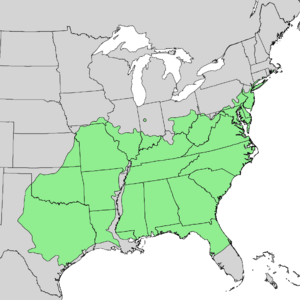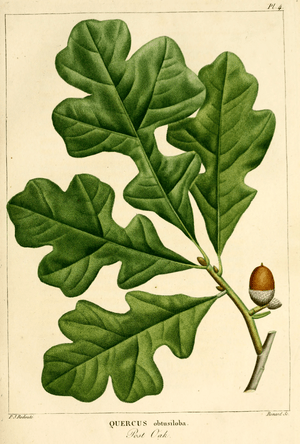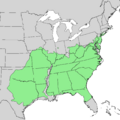Post oak facts for kids
Quick facts for kids Post oak |
|
|---|---|
 |
|
| The Houston Campsite Oak in Grapevine Springs Preserve, Coppell, Texas | |
| Conservation status | |
| Scientific classification | |
| Genus: |
Quercus
|
| Species: |
stellata
|
 |
|
| Natural range of Quercus stellata | |
| Synonyms | |
|
List
Quercus alba var. minor Marshall
Quercus floridana Shuttlew. ex A.DC. Quercus fusca Raf. Quercus gonoloba Raf. Quercus heteroloba Raf. Quercus lobulata Sol. ex Sm. Quercus minor (Marshall) Sarg. Quercus obtusiloba Michx. Quercus villosa Walter |
|
The Post Oak (also known as Quercus stellata or iron oak) is a type of oak tree found in North America. It belongs to the white oak family. This tree grows slowly and can live in tough places like dry fields or on top of hills. It's super strong and can handle fire, dry weather (drought), and even resist rotting! Different white oaks can sometimes mix, creating new kinds of hybrid trees.
Contents
What is the Post Oak?
The Post Oak tree is native to the eastern and central United States. You can find it along the east coast from Massachusetts all the way down to Florida. It also grows far inland, reaching places like Nebraska.
You can easily spot a Post Oak by looking at its leaves. They have a special rounded, cross-like shape. The underside of the leaves also feels a bit fuzzy or hairy.
How to Identify a Post Oak
The Post Oak is usually a small to medium-sized tree. Most Post Oaks grow to be about 10 to 15 meters (33 to 49 feet) tall. Their trunks are typically 30 to 60 centimeters (12 to 24 inches) wide. However, some very old trees can reach up to 30 meters (98 feet) tall and have trunks as wide as 140 centimeters (55 inches)!
Post Oak Leaves and Acorns
The leaves of the Post Oak are very unique. They have three main parts that stick out, making them look a lot like a Maltese cross. The leaves feel tough and leathery. If you look closely, you'll see tiny, star-shaped hairs on the bottom of the leaves.
The way the branches grow often makes the tree look strong and rugged. The acorns are about 1.5 to 2 centimeters (0.6 to 0.8 inches) long. They become fully grown during their first summer.
Naming the Post Oak
The scientific name for the Post Oak is Quercus stellata. The word stellata comes from Latin and means "star." This name was chosen because of the tiny, star-shaped hairs found on the underside of the leaves.
Post Oak Varieties
Scientists have identified several different types, or "varieties," of the Post Oak. One well-known variety is called Q. stellata var. paludosa, also known as the delta post oak.
Where Post Oaks Grow
The Post Oak is found across the Southern United States. It grows in coastal states from Massachusetts to Texas, and reaches inland to Iowa.
These trees usually grow at the edge of forests. They prefer dry, sandy areas that might not have a lot of nutrients in the soil.
Uses of the Post Oak Tree
The Post Oak is a very useful tree! Because it can grow well in dry places and has a nice shape, it's sometimes planted in cities.
Strong Wood for Many Uses
The wood from the Post Oak is very strong and resists rotting. This makes it great for many things, such as:
- railroad ties (the wooden beams under train tracks)
- siding for buildings
- planks and construction timbers
- Parts of stairs like risers and treads
- flooring
- Pulp (used to make paper)
- Veneer (thin slices of wood)
- particle board
- Fuel (for burning)
- And, as its name suggests, fence posts!
Food for Wildlife
The Post Oak also provides food for many animals. deer, turkeys, squirrels, and other rodents enjoy eating its nuts. However, the nuts contain a substance called tannin, which can be harmful to cattle.
In Central Texas, Post Oak wood is one of the most common types used for barbecue because of the flavor it adds to the food.
Post Oaks and Fire
Post Oak trees are very good at surviving fires. They have thick bark that helps protect them from flames.
Scientists can study the tree rings of Post Oaks to learn about the history of fires in an area. For example, a study of 36 Post Oaks in Illinois showed that some trees lived through more than 100 years of frequent fires, with fires happening almost every year!
Images for kids
See also
 In Spanish: Roble de los postes para niños
In Spanish: Roble de los postes para niños




